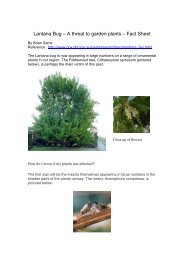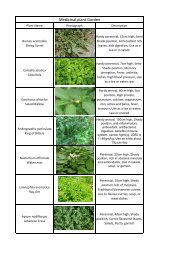Clivia pests - Wattletree Horticultural Services
Clivia pests - Wattletree Horticultural Services
Clivia pests - Wattletree Horticultural Services
You also want an ePaper? Increase the reach of your titles
YUMPU automatically turns print PDFs into web optimized ePapers that Google loves.
<strong>Wattletree</strong> <strong>Horticultural</strong> <strong>Services</strong><br />
<strong>Clivia</strong> <strong>pests</strong><br />
Fact Sheet<br />
By Brian Sams<br />
<strong>Clivia</strong>s are a very hardy group of plants. They are rarely troubled by <strong>pests</strong> and diseases<br />
and enjoy growing where few other flowering plants enjoy it—in a dry shady<br />
spot in the garden or in pots.<br />
<strong>Clivia</strong>s produce orange or yellow flowers in a huge variety of forms as shown here<br />
at the Toowoomba <strong>Clivia</strong> Show in Toowoomba TAFE 2010<br />
There are however a few <strong>pests</strong> that may occasionally cause problems including on<br />
recently discovered by Toowoomba horticulturist Ron May.<br />
The main <strong>pests</strong> of <strong>Clivia</strong>s are<br />
• Lily borers (Brithys crini and Spodotera picata)<br />
• Banana Fruit Caterpillar<br />
• Mealy bug<br />
Lily borers cause problems in <strong>Clivia</strong> by boring into the growing points of the plant<br />
and causing soft rots in the crown of the plant. As they are the larval stage of a moth<br />
control with chemicals registered for use on caterpillars will be effective. Professional<br />
growers will also usually treat infected plants with Sulphur to help prevent<br />
fungal attack that results from attack.<br />
a<br />
bri-
Banana Fruit Caterpillar was recently discovered to be a pest in <strong>Clivia</strong>s by<br />
Toowoomba horticulturist and keen photographer Ron May. Ron prepared the<br />
article below which he kindly allowed for reproduction in this fact sheet.<br />
Treatment options as for lily borer on page 1.<br />
briansams@netspace.net.au<br />
www.wattletreehorticulture.com.au<br />
(c) Copyright Brian Sams 2011
Mealy bug<br />
Mealybugs belong to the same group of insects as scale and aphids. They are a<br />
very common pest of indoor plants and plants growing in warm, humid, sheltered<br />
sites away from adverse environmental conditions and natural enemies. Mealybugs<br />
are so named because many of the known species are covered in a whitish ‘mealy’<br />
wax, which helps retard the loss of water from their soft bodies. Mealybugs can<br />
build up in huge numbers in a very short time and cause considerable damage.<br />
They feed by inserting their straw-like mouthparts, known as ‘stylets’, into plant tissue.<br />
Feeding damage can be either by direct removal of plant fluids and nutrients,<br />
and/or by the excretion of toxic salivary compounds into plant tissue. Black sooty<br />
mould which grows on the waste product (honeydew) of Mealybugs is often the first<br />
sign that Mealybugs have taken up residence. Ants may also act as farmers of Mealybugs<br />
as they are actively fed honeydew by some species of mealybug.<br />
The real problem with controlling mealy bugs is that they are so well hidden down in<br />
leaf axils and also often on the root systems of plants. This means that they tend to<br />
be difficult to knock down with any type of sprays (organic or more toxic sprays).<br />
Control<br />
Because mealybugs have high reproductive capacities and multiple generations in a<br />
year, they have the potential to become resistant to pesticides very quickly. The use<br />
of stronger and stronger pesticides breeds more and more resistant Mealybugs, until<br />
the stage is reached where efficient and practical chemical control of the pest is<br />
no longer possible. Fortunately mealybugs can be controlled using ‘soft’ methods<br />
including biological agents and low-toxicity pesticides, most of which are readily<br />
available to the horticultural industry and the home gardener. Confidor, oils sprays<br />
and pyrethrum based sprays are registered for use. For information on biological<br />
control agents such as predatory ladybirds and parasitic wasps contact Australasian<br />
Biological Control Association on the free call number 1800 000 160.<br />
Adapted from<br />
http://www.rbgsyd.nsw.gov.au/plant_info/<strong>pests</strong>_diseases/fact_sheets/mealybugs<br />
Summary<br />
<strong>Clivia</strong>s rarely need treatment for <strong>pests</strong> and diseases but watch out for stem borers,<br />
banana fruit caterpillars and mealy bugs.<br />
briansams@netspace.net.au<br />
www.wattletreehorticulture.com.au<br />
(c) Copyright Brian Sams 2011
















